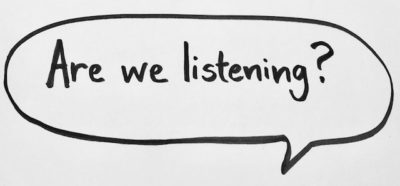How much do you value student voice? By the term “student voice” I am referring to the values, beliefs, opinions, and perspectives of the students in our classrooms. I think we all instinctively understand that student voice is important, but do we value it so much that we intentionally make room for it? Do we value it as much as we value teacher voice in the classroom?

This year, I am focusing on creating relationships that promote social emotional learning. I have become increasingly aware of what students are saying, and, consequently, of what teachers are saying about their students. Although I am finding the student voices in my classroom to be informative and invigorating to the learning environment, it is clear that some educators are often frustrated with what students have to say.
Personally, I find joy in my classroom listening to the voices of my students. Every day I learn something new. Every day I laugh. My students bring life to my classroom and they fill my days with their varied perspectives, diverse backgrounds, interesting opinions and wild imaginations. My walls display their work. My units shift and change with their contributions and preferences. Every time I read a novel with a class, I see it through different eyes and hear it through different voices. Every time I give them a controversial topic to discuss, I hear a new perspective and learn a little more about their generation and our community.
I thrive in a sea of student voices. This is why it is so hard for me to understand how some educators are disinterested in the voices and opinions of their students. In fact, in many classrooms, there is still an old-fashioned dynamic in which the teacher’s voice and opinions dominate. Sadly, in some cases, the students are taught that they are not going to be successful until they concur with the teacher: There is one right answer, one correct perspective, one way to complete a task. Do what you are told. Be what we tell you to be.
There are still teachers who view some students as unmotivated or unable to learn. These teachers tend to give students work with predictable answers and few opportunities for creative expression. It’s all or mostly teacher-to-student talk. Students do what they are told, or they face discipline. Not coincidentally, students of color and students in poverty are subjected to more discipline in school.
To me, a subdued, compliant, teacher-dominated classroom sounds boring and bleak, but I do understand that it is less chaotic, more easily planned, assessed, and controlled. It suits those who want a calm and quiet classroom. If you suppress student voice, the benefits include less noise, fewer disagreements, and the illusion that the teacher is always the authority. On the downside, denying student voice is a sign of low expectations. At its worst, it suppresses diverse cultures with dominant culture ideals. It is condescending. It is inherently racist and classist.
Conversely, the benefits of valuing and encouraging student voice include stronger relationships with students, a climate of trust and sharing, increased student choice and influence on the learning, and a rise in self-advocacy. Students become stakeholders, building 21st Century Skills as leaders and communicators, and teachers receive increased feedback for improved instruction. At its best, an environment that encourages strong student voices is ideal for growth, achievement, and preparation for success after high school.
I would love to hear some ways that all of you amazing educators out there encourage, promote, and celebrate the voices in your classroom. Let’s share and help others see the value of student voice.
In the meantime, here are some of helpful links:
A comprehensive report on elevating student voice from the Center for American Progress
CSTP’s Student Perception Survey (a great way to get the direct feedback we need)
Thank you for sharing your thoughts on this Lynne. I started at my elementary school in 2001 when my eldest child entered first grade. I was a parent volunteer, an educational assistant, and then a para-educator before getting my teaching license. These different roles gave me a vantage point that few individuals see. I was in numerous classrooms over the years, and as you stated, the energy is palpable in spaces where students are encouraged to offer their perspective. Student engagement tends to be much higher compared than in the rooms where the sage is on the stage. After a decade in charge of my own classroom, I have come to realize the importance of providing a safe and organized space where children are given the tools to express themselves and do their personal best. That said, my kindergarten students are very eager to share all their stories all the time. We have come to an understanding regarding the necessary balance between always wanting to share an immediate thought and how to listen to others, whether a peer, parent, or teacher!
AND a key to soliciting student voice is the adult’s (or system’s) willingness to actually do something different when that voice tells us something we might not want to hear…
Kids figure out quickly whose voices get listened to and whose don’t… just as we adults do in our systems as well.